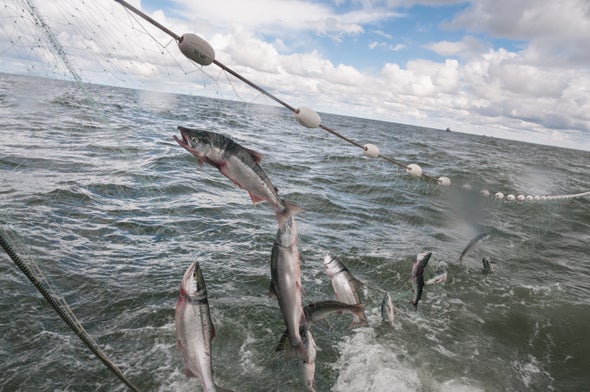(单词翻译:单击)
听力文本
This is Scientific American's 60-second Science, I'm Julia Rosen.
Every year, salmon come home to Alaska's frigid rivers to mate, lay their eggs and die. The state's salmon runs are some of the biggest in the world. But over the past few decades, those big salmon runs have featured ever smaller salmon.
"You talk to people up there who've been fishing for long time, and they're definitely able to tell you that, you know, we just don't see those really large, old salmon that we used to see."
Krista Oke, a postdoctoral fellow at the University of Alaska Fairbanks. Oke and colleagues at the University of California, Santa Cruz, and elsewhere analyzed records of fish size going back to the 1950s. They included data on some 12.5 million salmon—each of which had to be measured by someone from the Alaska Department of Fish and Game. And there's no question about it: salmon have shrunk.
Sockeye salmon today are 2.1 percent shorter than their ancestors. Chum salmon are 2.4 percent shorter, and coho are 3.3 percent shorter. Chinook, or king, salmon showed the greatest declines at 8 percent. That's an average difference of more than two inches in length. The study is in the journal Nature Communications.
The researchers haven't nailed down the exact reasons behind this trend. But their analysis suggests that climate change and competition with wild and hatchery-raised salmon both play a role. They also discovered that much of the change in body size is due to fish returning from the ocean at a younger age now than in the past.

Oke says fish could be returning earlier because they're reaching maturity faster for some reason—or because the ocean has become a riskier place for older salmon to survive.
"What could be happening is the salmon that otherwise would have returned large and old just aren't making it that long."
Whatever the cause, this size shift has massive ramifications for people and the environment. Oke and her team calculated that catching smaller fish may have already slashed the value of Alaska's commercial salmon fisheries by 21 percent. It's also likely reduced the food available to subsistence fishers—many of whom rely on stores of salmon to get them through the long, harsh winter—by as much as 26 percent.
On the ecological side, the researchers estimated that smaller fish lay 16 percent fewer eggs, which could depress salmon populations in the future. And the salmon bring 28 percent fewer nutrients into the watersheds where they spawn, according to the study.
"After they breed and die, their carcasses actually fertilize freshwater and terrestrial ecosystems with these marine-derived nutrients that are really important and that get used by all kinds of animals, like bears and songbirds, and even taken up into trees."
With no single factor to blame for shrinking salmon, there's no obvious fix, Oke says. But there are still plenty of fish in the sea. They're just smaller than they used to be.
Thanks for listening for Scientific American's 60-second Science, I'm Julia Rosen.
参考译文
这里是科学美国人——60秒科学系列,我是朱莉娅·罗森。
每年,鲑鱼都会回到阿拉斯加寒冷的河流里交配、产卵和死亡。阿拉斯加州的鲑鱼洄游,有些是全世界规模最大的。但过去几十年,这些大规模鲑鱼洄游中的鲑鱼个头越来越小。
“如果你和长期在那里捕鱼的人聊天,他们肯定会告诉你,他们看不到以前那些个头大且年老的鲑鱼了。”
阿拉斯加费尔班克斯大学的博士后研究员克里斯塔·奥克说到。奥克和加州大学圣克鲁斯分校及其他地方的同事分析了可追溯到上世纪50年代的鲑鱼体型记录。这包括约1250万条鲑鱼的数据,每一条鲑鱼都必须由阿拉斯加渔猎局的人员测量。毫无疑问:鲑鱼变小了。
如今的红鲑比它们的祖先短了2.1%。狗鲑短了2.4%,银鲑短了3.3%。奇努克鲑或国王鲑的降幅最大,为8%。身长平均差异超过两英寸。这项研究发表在《自然通讯》期刊上。
研究人员尚未弄清这一趋势背后的确切原因。但他们的分析表明,气候变化以及野生鲑鱼和孵化养殖鲑鱼的竞争都起到了作用。他们还发现,体型的变化很大程度上是由于从海洋洄流返回的鲑鱼年龄比过去要小。
奥克表示,鲑鱼更早返回,是因为它们出于某些原因更快地到达了成熟期,或者因为海洋已成为老龄鲑鱼生存的更危险场所。
“可能的情况是,鲑鱼原本返回时可以更大更年长,但它们只是没能长到那么长。”
无论是什么原因,这种体型的转变对人类和环境都有巨大的影响。奥克及其团队计算出,捕获较小的鱼可能已使阿拉斯加商业鲑鱼渔业的价值下降了21%。这还可能使自给自足的农民可获得的食物减少26%之多,而他们中的许多人都依赖储存鲑鱼来度过漫长的严冬。
在生态方面,研究人员估计,较小的硅鱼产卵量减少了16%,这可能会在未来抑制鲑鱼的数量。研究表明,鲑鱼带到产卵流域的营养物质减少了28%。
“在繁殖和死亡后,鲑鱼的尸体会用这些源自海洋的营养物质为淡水和陆地生态系统施肥,这些营养物质非常重要,它们会被熊和禽等各种动物利用,甚至会被树木吸收。”
奥克表示,由于鲑鱼体型萎缩无法归咎于单一因素,因此没有明显的解决方法。但海里仍有很多鱼。它们只是比以前小了而已。
谢谢大家收听科学美国人——60秒科学系列,我是朱莉娅·罗森。
译文为可可英语翻译,未经授权请勿转载!
重点讲解
重点讲解:
1. no question 毫无疑问;
There's no question she is the best comedienne in this country.
她无疑是该国最优秀的女喜剧演员。
2. nail down 弄清;确定;
It would be useful if you could nail down the source of this tension.
如果你能弄清这种紧张的根源,将会大有益处。
3. rely on 依赖;依靠;
Lions rely on stealth when hunting.
狮子捕食全凭偷袭。
4. get through 度过,熬过(困难或不快的时期);
It is hard to see how people will get through the winter.
难以想象人们将怎样熬过这个冬天。
关注微信公众号【可可双语精读】,获取详细讲解内容


